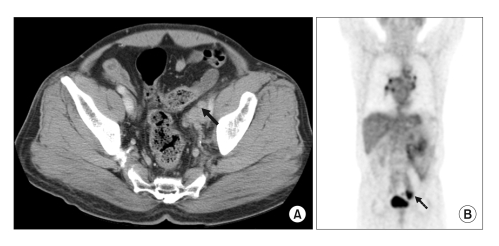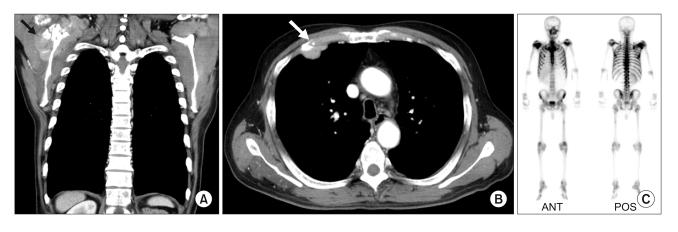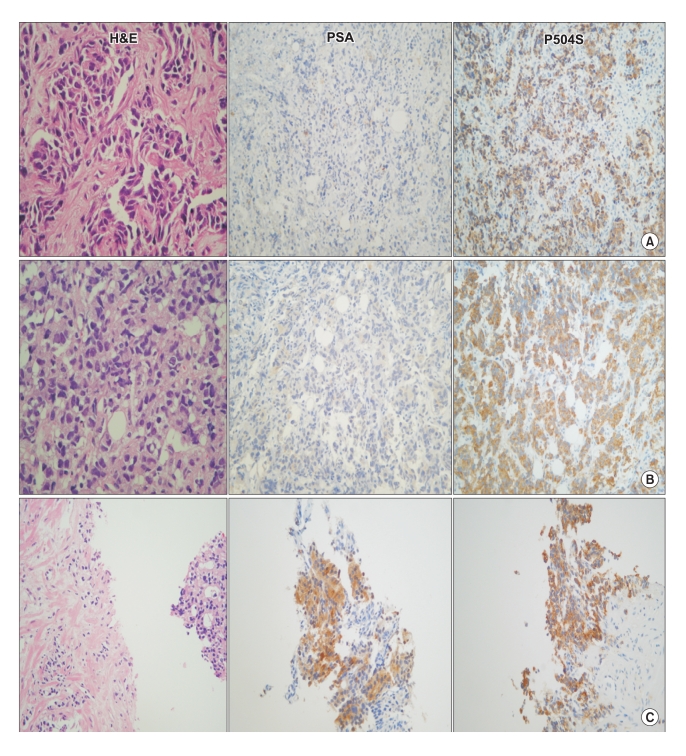Cancer Res Treat.
2009 Mar;41(1):45-49.
Cancer of Unknown Primary Finally Revealed to Be a Metastatic Prostate Cancer: A Case Report
- Affiliations
-
- 1Department of Internal Medicine, School of Medicine, Ewha Womans University, Seoul, Korea. snlee@ewha.ac.kr
- 2Department of Pathology, School of Medicine, Ewha Womans University, Seoul, Korea.
Abstract
- The vast majority of patients with metastatic prostate cancer present with bone metastases and high prostate specific antigen (PSA) level. Rarely, prostate cancer can develop in patients with normal PSA level. Here, we report a patient who presented with a periureteral tumor of unknown primary site that was confirmed as prostate adenocarcinoma after three years with using specific immunohistochemical examination. A 64-year old man was admitted to our hospital with left flank pain associated with masses on the left pelvic cavity with left hydronephrosis. All tumor markers including CEA, CA19-9, and PSA were within the normal range. After an exploratory mass excision and left nephrectomy, the pelvic mass was diagnosed as poorly differentiated carcinoma without specific positive immunohistochemical markers. At that time, we treated him as having a cancer of unknown primary site. After approximately three years later, he revisited the hospital with a complaint of right shoulder pain. A right scapular mass was newly detected with a high serum PSA level (101.7 ng/ml). Tissues from the scapular mass and prostate revealed prostate cancer with positive immunoreactivity for P504S, a new prostate cancer-specific gene. The histological findings were the same as the previous pelvic mass; however, positive staining for PSA was observed only in the prostate mass. This case demonstrates a patient with prostate cancer and negative serological test and tissue staining that turned out to be positive during progression. We suggest the usefulness of newly developed immunohistochemical markers such as P504S to determine the specific primary site of metastatic poorly differentiated adenocarcinoma in men.
MeSH Terms
Figure
Reference
-
1. Pavlidis N, Briasoulis E, Hainsworth J, Greco FA. Diagnostic and therapeutic management of cancer of an unknown primary. Eur J Cancer. 2003; 39:1990–2005. PMID: 12957453.
Article2. Ministry of health and welfare. Central cancer registry center. regional cancer registry. Annual report of the cause of death in Korea 2006.3. Varadhachary GR, Abbruzzese JL, Lenzi R. Diagnostic strategies for unknown primary cancer. Cancer. 2004; 100:1776–1785. PMID: 15112256.
Article4. Greco FA, Hainsworth JD. DeVita VT, Hellman S, Rosenberg SA, editors. Cancer of unknown primary site. Cancer: principles and practice of oncology. 2005. 7th ed. Philadelphia, PA: Lippincott;p. 2213–2236.5. Polascik TJ, Oesterling JE, Partin AW. Prostate specific antigen: a decade of discovery: what we have learned and where we are going. J Urol. 1999; 162:293–306. PMID: 10411025.6. Thompson IM, Pauler DK, Goodman PJ, Tangen CM, Lucia MS, Parnes HL, et al. Prevalence of prostate cancer among men with a prostate-specific antigen level < or =4.0 ng per milliliter. N Engl J Med. 2004; 350:2239–2246. PMID: 15163773.7. Goldstein NS. Immunophenotypic characterization of 225 prostate adenocarcinomas with intermediate or high Gleason scores. Am J Clin Pathol. 2002; 117:471–477. PMID: 11888088.
Article8. Sheridan T, Herawi M, Epstein JI, Illei PB. The role of P501S and PSA in the diagnosis of metastatic adenocarcinoma of the prostate. Am J Surg Pathol. 2007; 31:1351–1355. PMID: 17721190.
Article9. Xu J, Stolk JA, Zhang X, Silva SJ, Houghton RL, Matsumura M, et al. Identification of differentially expressed genes in human prostate cancer using subtraction and microarray. Cancer Res. 2000; 60:1677–1682. PMID: 10749139.10. Jiang Z, Woda BA, Rock KL, Xu Y, Savas L, Khan A, et al. P504S: a new molecular marker for the detection of prostate carcinoma. Am J Surg Pathol. 2001; 25:1397–1404. PMID: 11684956.11. Rubin MA, Zhou M, Dhanasekaran SM, Varambally S, Barrette TR, Sanda MG, et al. Methylacyl Coenzyme A Racemase as a tissue biomarker for prostate cancer. JAMA. 2002; 287:1662–1670. PMID: 11926890.
Article12. Beach R, Gown AM, De Peralta-Venturina MN, Folpe AL, Yaziji H, Salles PG, et al. P504S immunohistochemical detection in 405 prostatic specimens including 376 18-gauge needle biopsies. Am J Surg Pathol. 2002; 26:1588–1596. PMID: 12459625.
Article13. Chuang AY, DeMarzo AM, Veltri RW, Sharma RB, Bieberich CJ, Epstein JI. Immunohistochemical differentiation of high-grade prostate carcinoma from urothelial carcinoma. Am J Surg Pathol. 2007; 31:1246–1255. PMID: 17667550.
Article14. Martínez-Rodríguez M, Ramos D, Soriano P, Subramaniam M, Navarro S, Llombart-Bosch A. Poorly differentiated adenocarcinomas of prostate versus high-grade urothelial carcinoma of the bladder: a diagnostic dilemma with immunohistochemical evaluation of 2 cases. Int J Surg Pathol. 2007; 15:213–218. PMID: 17478786.
Article
- Full Text Links
- Actions
-
Cited
- CITED
-
- Close
- Share
- Similar articles
-
- A case of metastatic squamous cell carcinoma of the mediastinum with unknown primary tumor
- Chemotherapy With Androgen Deprivation for Hormone-Naïve Prostate Cancer
- A case of metastatic adenocarcinoma of bladder from stomach cancer
- Expression of Survivin Correlated with Antiapoptosis in Benign Prostate Hyperplasia and Prostate Cancer
- A Case of Squamous Cell Carcinoma of the Oral Cavity with Simultaneous Metastatic Adenocarcinoma of the Neck from an Unknown Primary




